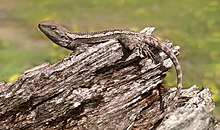Jacky dragon
| Jacky dragon | |
|---|---|
 |
|
| Scientific classification | |
| Kingdom: | Animalia |
| Phylum: | Chordata |
| Class: | Reptilia |
| Order: | Squamata |
| Suborder: | Iguania |
| Family: | Agamidae |
| Genus: | Amphibolurus |
| Species: | A. muricatus |
| Binomial name | |
|
Amphibolurus muricatus (White, 1790) |
|
The jacky dragon (Amphibolurus muricatus) is a type of lizard native to southeastern Australia. It was one of the first Australian reptiles to be named, originally described by English zoologist George Shaw in Surgeon-General John White’s Journal of a Voyage to New South Wales, which was published in London in 1790. It is well known for its bright yellow mouth and well-developed vertebral crest, as well as the temperature-dependent sex determination of its offspring. Other common names include blood-sucker, stonewalker, and tree dragon.
The jacky dragon, one of the 70 species of dragons (Agamidae) found in Australia, is generally diurnal and tends to run in an upright posture when pursued. Common morphological characteristics include rough, nonglossy scales; broad, thick, and fleshy tongues; and well-developed limbs, especially hind limbs which are generally longer and have five-clawed digits. Most dragons are also characterized by a lack of tail autotomy and the presence of femoral and/or preanal pores. Agamidae dragons are also oviparous and tend to deposit their eggs in burrows.
The coloration of the jacky dragon is pale grey to dark brown with dark patches along the middle of the back. The dark patches are interrupted by pale blotches that often blend together to form a continuous stripe from above the arm to the groin. A dark brown bar is present between the eye and the ear, but no dark stripe is present between the nostril and the eye as in many other dragons. The lips and lower jaw tend to be of a lighter coloration than the rest of the head. Jacky dragons are also characterized by a bright yellow lining in their mouths. . Specimens have been seen with orange-red corners of the inside of their mouths, which may have given rise to the common name of blood-sucker.
...
Wikipedia
